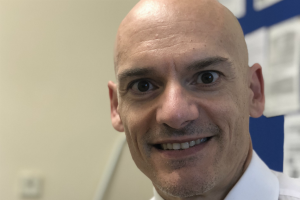Dr Edoardo Cervoni was ahead of the curve when, in 2016, he identified a potential over-prescription of opioids to patients at his practice. He conducted a review of opioid use to reduce addiction rates and slashed prescriptions by educating patients on pain management, earning him a shortlist place at the prestigious General Practice Awards.

Profile: Dr Edoardo Cervoni
What’s your role? Part-time locum at Central Park Surgery in Leyland, Preston
How long have you been a GP? 25 years
How would you describe your practice?
A medium-sized practice with 4,500 patients in an area with pockets of deprivation and a high prevalence of mental health problems, addiction and long-term conditions. There are also many non-English speaking patients
What gets you up in the morning?
My motto is ‘semper da optimum’, which can be rephrased as ‘always give your very best to make a positive difference, irrespective of the tasks you will be facing today’.
What problems was the practice facing?
Central Park Surgery, like many other surgeries, had an increasing number of patients on long-term opiates. There was no formalised reviewing process, leaving them at risk of abuse, addiction, and hyperalgesia. In addition, this meant the cost of prescribing these drugs was prohibitively high. In 2016, I strongly believed that this needed to be addressed to improve patient welfare and bring costs down and that these patients needed to be reviewed regularly. I had a meeting with the partners and practice manager explaining the rationale for the review, supported by literature data, so it was relatively easy to get them fully on board.
What did you do?
Following an EMIS population search, I conducted a review of all patients who were on opiates to try to reduce the incidence of opioid overuse and addiction, which is becoming a national problem. I applied the principles of the NICE guidelines on analgesia for mild-to-moderate pain, as well as those on use of opioids in palliative care for palliative patients. Educating patients on the risks of these types of medication was crucial, as was supporting them to implement alternative pain management strategies, such as giving healthy living advice.
All patients on opioids are now reviewed every six months, and the prescribing tailored according to patients’ needs, mutually agreed with patients, and in line with the 2016 CDC guidelines, which provide recommendations on prescribing opioids for chronic pain outside of active cancer treatment, palliative care, and end-of-life care. I also refer to American Pain Society and the American Academy of Pain Medicine 2009 authoritative guidelines for opioid treatment of non-cancer pain.
What were the challenges?
There has been a lot of discussion in the national press about overuse of opioids and the problems associated with addiction. However, my initiative to review pain medication preceded this media attention, so there was less understanding of the issues. It is often challenging to attempt to modify patients’ behaviour, especially when they are in chronic pain and new strategies to manage it take time to become effective. This meant I had to persevere and be forthright when it comes to having difficult conversations with patients.
What improvements did you see?
In 2016, 87 patients were on regular dihydrocodeine. Following review, this figure fell to 69 in 2017, a 21% reduction. The number of patients on tramadol decreased from 83 to 47 in the same period, a reduction of 43%. A further 12 patients were converted to modified-release versions of the opioid for safety and five patients with non-neoplastic pain were referred to the chronic pain team.
Collectively, this has slashed the costs of opioid prescribing and improved patient safety and wellbeing. Among them were several elderly patients who found themselves to be less tired, confused and forgetful with rather significant practical benefits.
Once I had illustrated the reasons behind my advice, very rarely did the patients object; we were then largely successful in reducing – in many cases stopping completely – opiate prescribing.
What colleagues say
Dr Patel, GP principal: ‘I have known and worked alongside Dr Cervoni for three years, and he is by far the most dynamic, forward-thinking GP I have ever met. He works as a locum, but he acts as a principle GP at the practice, trying to achieve the best and safest outcomes for patients.’
Kim Leech, advanced nurse practitioner and partner: ‘Dr Cervoni’s hard work, persistence and dedication to reducing a national problem on a local basis are admirable. The progress that he has achieved at this surgery alone is remarkable. It is also important to emphasise that in the era we live in, with workforce shortages and a reluctance of GPs to become partners in general practice, we rely heavily on the locum population and Dr Cervoni proves that locums are as effective – if not more so – and are an essential resource. He is an admirable doctor who puts patients first.’
Pulse July survey
Take our July 2025 survey to potentially win £1.000 worth of tokens












non-neoplastic pain were referred to the chronic pain team.
Update on NICE guidelines
we rely heavily on the locum population
REGUALR REV NEED IT TO PREVENT ADDICTION
DOSE CONVERSION IN OPIATE IS VERY IMPROTANT TO PREVENT OVERDOSE
ALWAYS FOLLOW NICE GUIDELINE FOR OPIAT ANALGESIA
OPIATE IS NOT SUITABLE FOR NEURPATHIC PAIN
everal elderly patients who found themselves to be less tired, confused and forgetful with rather significant practical benefits.